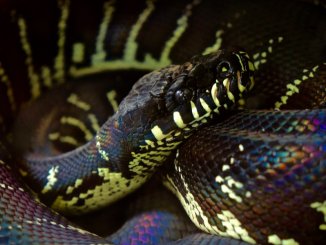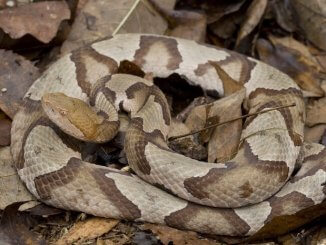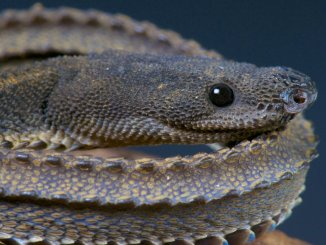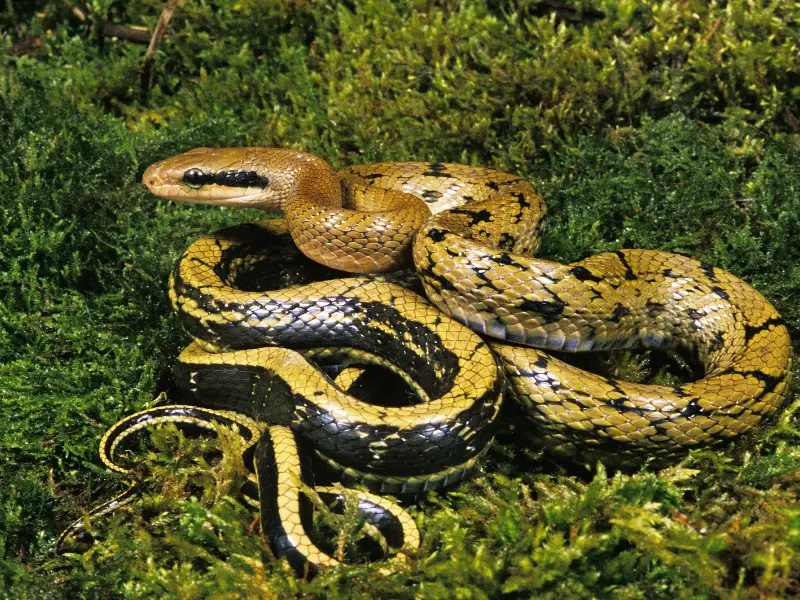
The Taiwan beauty snake is a beautiful snake with a pattern of olive-brown splotches over yellow coloring. It has several distinctive dark lines running from its eyes to its mouth.
While beauty snakes are found all over Asia, Taiwan beauty snakes are only found in Taiwan, which is how they get their name.
These snakes have relatively standard care requirements but can be a bit shy and moody. This temperament makes them best suited for those with intermediate experience owning and handling snakes.
Taiwan Beauty Snake Overview
| Common name | Taiwan Beauty Snake |
| Scientific name | Orthriophis taeniura friesei |
| Natural habitat | This subspecies of beauty snake is naturally found only in Taiwan. They prefer rainforests and sometimes live in caves. |
| Adult size | 4 ft - 8.5 ft (females are bigger than males) |
| Average lifespan | 10-15 years in the wild, 15-25 years in captivity |
| Diet | Rats and other rodents. |
| Housing | 4ft x 2ft x 3ft. Need extra height for climbing tree branches. |
| Experience | Intermediate |
Origin
The Taiwan beauty snake (Orthriophis taeniura friesei) originates from Taiwan. They live in various habitats but typically prefer rainforests, agricultural areas, and being near bodies of water.
The Taiwan beauty snake is semi-arboreal, meaning it spends a good portion of its life in tree branches.
As humans encroach on natural land, they more often encounter these snakes. This is especially true for construction sites.
The snakes are drawn here by the rodents that live in and around construction sites.
Getting a Taiwan beauty snake from a breeder is crucial if you want a docile pet snake.
Wild-caught snakes are often aggressive and don’t acclimate well to captivity.
In terms of conservation status, these snakes are considered vulnerable in Taiwan and most of Asia.
In certain parts of Japan, however, they are considered to be an invasive species.
Appearance And Behavior
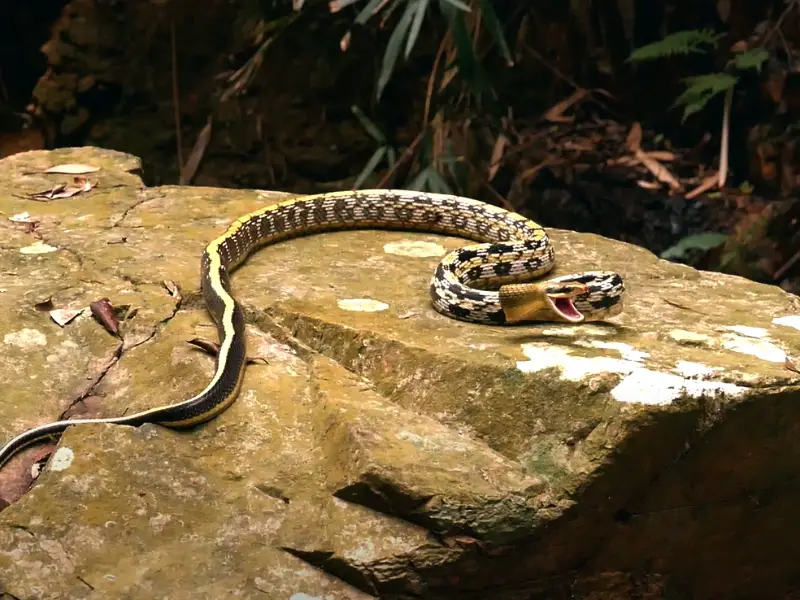
The Taiwan beauty snake is a thin-bodied snake with yellow coloring. It has several brown splotches that get darker along the body.
On the back, two pairs of round black spots meld together, creating the appearance of a tail stripe.
One of the most distinctive features of the Taiwan beauty snake is its eye pattern. They have a black stripe coming from the back of their eye to their mouth.
The Taiwan beauty snake is a cathemeral animal. Most animals are either nocturnal (active during the night) or diurnal (active during the day).
However, cathemeral animals are randomly active during the day or night. They often take small naps to gain energy instead of having a 12-hour sleep-wake cycle.
Size And Lifespan
Taiwan beauty snakes live between 15 to 25 years. Getting one of these snakes as a pet is a long-term, serious commitment. With proper care, these snakes can live very long and happy lives.
The average Taiwan beauty grows between 4 to 6 ft in length. Females are larger and often grow to 7ft or 8ft.
Keep in mind that there are records of these snakes reaching up to 8.5 ft. Unlike most beauty rat snakes, the Taiwan beauty is long and slender.
Temperament
Wild-caught Taiwan beauty snakes can be aggressive. They will often strike at their enclosure and sometimes at people.
Despite this, the Taiwan beauty snake isn’t naturally aggressive. It only displays this aggressive behavior because it struggles to adapt to life in captivity.
In contrast, captive-bred snakes aren’t aggressive but are rather quite shy. This attitude makes them unsuitable as beginner-friendly pet snakes.
You will have to put in a lot of work to bond with your snake.
You can house Taiwan beauty snakes together but will need a big enclosure. They aren’t particularly territorial or aggressive, but most owners house them separately.
This makes it easier to clean and handle the snakes.
These snakes aren’t the easiest to handle because of their shy temperament. Despite this shyness, they are unlikely to bite their owners.
As a non-venomous snake, the Taiwan beauty still sports a painful bite.
Housing The Taiwan Beauty Snake
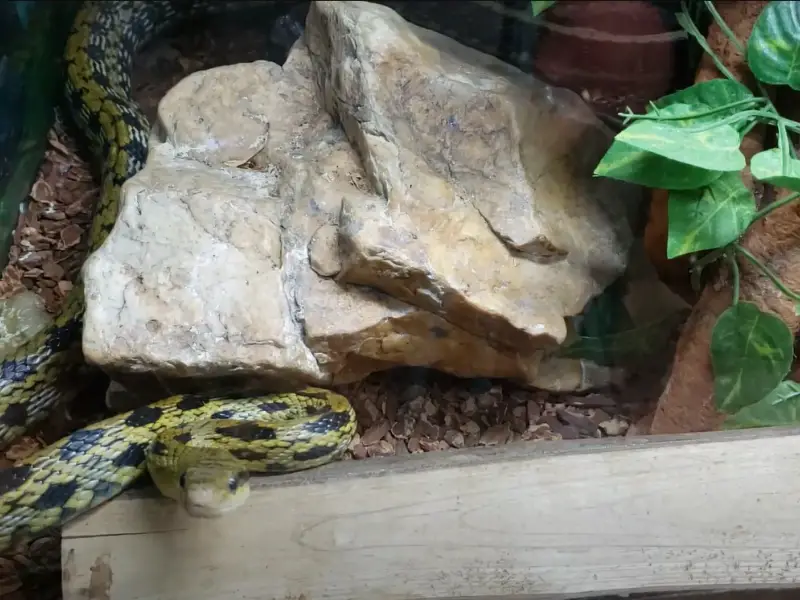
Taiwan Beauty snakes cope best in warmer environments.
If you live in a cold place, a wooden vivarium is a good choice of enclosure because it is better at holding in heat. However, if you live in a temperate area, there is nothing wrong with a standard snake terrarium.
Taiwan beauty snakes are a subspecies of rat snakes. Rat snakes are one of the most popular species of pet snakes in the U.S.
They’re so popular because they make good pets if well-taken care of and housing them is relatively straightforward.
Enclosure Size
Because of their climbing nature, Taiwan beauty snakes require tall enclosures. A suitable size enclosure for an adult snake is 4 ft long, 2 ft wide, and 3 ft tall.
Since the Taiwan beauty is a large, active snake, it needs enough space to move around.
In particular, these snakes require tall enclosures because of their climbing instinct.
Your enclosure must be large enough to include branches for them to climb and elevated perches for them to rest on.
Lighting
Even though these snakes are cathemeral, keeping the enclosure lights on a natural cycle is a good idea. This allows them to have a sleep-wake cycle that resembles what they would experience in the wild.
To help with this, keep the lights on for 12 hours daily, allowing your snake plenty of time to bask.
Place the lighting fixture on the warm side of your enclosure. You must ensure that it doesn’t increase the temperature above the ideal levels.
Use a thermometer to ensure that you’re getting an accurate temperature reading in your enclosure.
Unlike many other reptiles and snakes, the Taiwan beauty does not require special UVB lighting.
Temperature And Humidity
Because these snakes originate in Asia, they need quite a high ambient temperature in their enclosure. As with other snakes, you must ensure that one side of the enclosure is kept warm and the other cooler.
For Taiwan beauty snakes, the warmer side of the enclosure should be between 85°F and 90°F. To help you maintain this temperature, you can use a heating pad or mat, or a basking lamp. It’s essential to put this on one side of the enclosure and not in the middle.
Your snake can move between the warmer and cooler areas inside the enclosure to regulate its body temperature. As a cold-blooded animal, it relies on external heat sources to thermoregulate.
For the cooler side of the enclosure, you should maintain a temperature of 75 – 80°F. To monitor this, you invest in thermometers designed for snake enclosures. Heat exhaustion is a real risk to snakes, so you should never guess the temperature in the enclosure.
The enclosure should be cooler at night, with a temperature of 68 – 72°F. This cooler temperature simulates an environment closer to life outside in the wild.
Taiwan beauty snakes need a humidity level of around 50 – 60%, and you can measure this using a hygrometer.
If your humidity is too low, you can mist the enclosure daily to keep it sufficiently moist. If your humidity is too high, increase the ventilation or use a smaller water bowl.
When Taiwan beauty snakes shed, they need a much higher humidity level to help with the process. When shedding, they require 70 – 80% humidity to help them shed more quickly.
You’ll be able to tell when your snake is preparing to shed when its scales go dull, its eyes become cloudy, and they become less active.
Substrate And Decoration
The most commonly recommended substrate for Taiwan beauty snakes is wood chips or shards, including beech, fir, and aspen. They help maintain consistent humidity levels and replicate the wild forests where these snakes live.
You also need to provide a basking stone where your snake can lay under the basking lamp. Place the basking stone on the warm side of the enclosure. Be careful that the stone isn’t too close to the light and doesn’t get too hot.
On the cooler side of the enclosure, you can include a damp hide to allow the snake somewhere to cool off. Sphagnum moss is a good choice of substrate for the hide, which holds moisture well and creates a cool, dark environment. You can also use a plastic container to create a hide, as long as your snake can fit in it.
The basking stone and hide provide the balance that your snake needs to be healthy. Another essential decoration is tree branches for your Taiwan beauty snake to climb. As a semi-arboreal species, your pet will appreciate many branches to climb and explore.
Cleaning
It’s vital to keep your pet Taiwan beauty snake’s enclosure clean. Do daily spot cleaning and remove any droppings.
Deep clean the enclosure once a month. Using household cleaners can be dangerous for the snake. Always use cleaning products designed for reptile enclosures.
During this monthly deep clean, replace the substrate. It’s crucial to thoroughly sanitize everything in the enclosure to ensure that no buildup of germs and bacteria harms your snake.
You can place your snake in a plastic bucket with ventilation holes when cleaning the enclosure.
Remember to scrub your snake’s water bowl once a week to prevent slime or bacteria from building up.
Lastly, replace the water in the bowl daily to ensure the snake has access to fresh, clean water.
Taiwan Beauty Snake Care
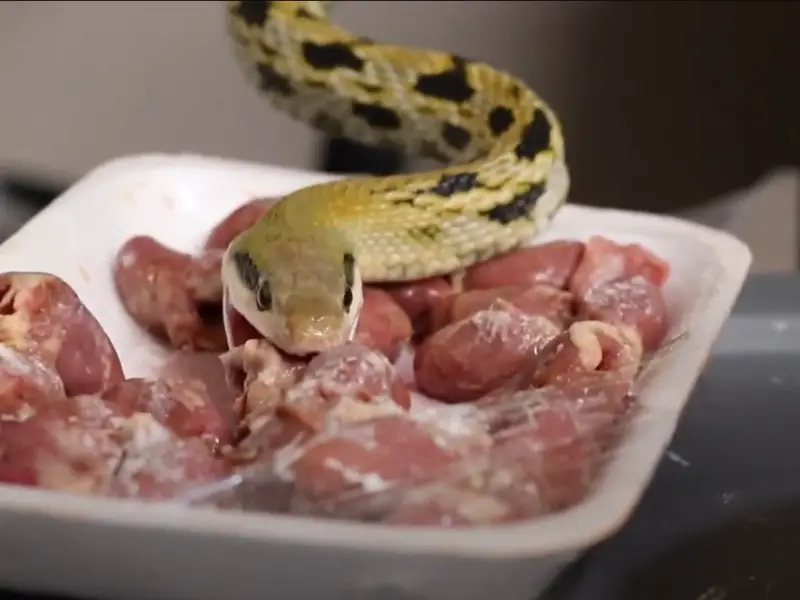
Taiwan beauty snakes are best for people with some snake-handling experience. While they are unlikely to be aggressive, they can be a bit unpredictable when they feel threatened. If you ensure that the following conditions are met, your pet snake can live a long, happy life.
Food And Water
Hatchlings and juvenile Taiwan beauty snakes should be fed pinky mice every 5 days. Feeding more often than this can lead to health problems, including obesity.
A good rule of thumb when it comes to feeding snakes is that the food you are feeding is no wider than the circumference of the snake at its widest point. This rule is valid throughout your snake’s lifespan.
Adult Taiwan beauty snakes should be fed frozen rats weekly or every 10 days. You will need to judge how often to feed based on your specific snake. Rats are more nutritional than mice, but a varied diet will also benefit your snake. You could introduce baby chicks as a treat when your snake is fully grown.
With the Taiwan beauty snakes, it’s imperative to use tongs when feeding. This prevents them from associating your smell with food. When they associate your smell with food, they may strike out and bite you, thinking it’s food.
If you choose to feed outside the enclosure, you can place the snake in a plastic container lined with newspaper. Always ensure that the tub you are using has adequate ventilation.
Don’t handle your snake for 24 hours before feeding and around 48-72 hours afterward. Holding the snake while digesting its last meal can disturb the process and cause regurgitation.
For water, you must provide your snake with a drinking bowl large enough for them to soak in and heavy enough that it can’t knock it over. You should change this water daily to ensure it is always clean and fresh.
Handling
When handling Taiwan beauty snakes, a certain level of skill is required. They aren’t beginner-friendly snakes. If you’re dealing with a wild-caught snake, it’s unwise to try to handle them.
This is one of the reasons why it’s best to get your snake from a reputable breeder. The breeder should have been handling and properly acclimating the snake to life in captivity from a young age. This treatment makes them much more docile and tolerant of handling.
When you first get your snake, leave it alone for a few days to allow it to settle into its new environment before you start to handle it. Then, hold it for a short time at first, gradually increasing the time it spends outside its enclosure.
Common Health Issues
While they are typically robust snakes, there are a few health issues that owners of Taiwan beauty snakes should be able to recognize. The most important thing to do is keep a close eye on your snake so that you can catch any changes as soon as they occur.
- Obesity: There is a risk of obesity and fatty liver disease from overfeeding. Pay attention to the feeding schedule provided in this care guide. Your snake will be healthy and happy if you don’t overfeed it.
- Abnormal shedding: Dysecdysis or abnormal shedding is when your snake is shedding in patches. This often indicates dehydration. Increase the humidity level and ensure that your snake is soaking.
- Scale rot: If your Taiwan beauty displays scale rot or blisters, you need to lower the humidity and ensure they thoroughly dry off. If this does not solve the issue, it could be a sign of some other underlying disease or parasite. You should immediately take your pet to the vet to ensure it gets the best treatment and chance of recovery.
Breeding
Taiwan beauty snakes can breed without brumation (hibernation in cold-blooded animals). However, a three-month brumation period helps with breeding. Lower the temperature to around 65°F as you enter winter, and keep the enclosure dark.
This lower temperature signals to the snake that it’s time to brumate. You shouldn’t feed the snake for three weeks before it brumates and continue starving it while it’s brumating. At the end of the 3 months, return the lighting and heating to normal levels.
You can then introduce the male snake into the female’s enclosure. Breeding should occur without intervention. Once your female snake is pregnant, provide calcium supplements to ensure that she and the babies remain healthy.
Taiwan beauty snakes generally lay clutches of 4-12 eggs. Once laid, eggs should be removed and kept in an incubator at 80-85°F. Ensure the humidity level is around 70-80%.
The eggs should hatch after around 60 days. You should only begin feeding the hatchlings after their first shed, and remember to start with pinky mice. Be careful not to overfeed the hatchlings.
Choosing And Buying A Taiwan Beauty Snake
Taiwan beauty snakes are relatively common, and you can buy them for around $200. These snakes are also legal to own in the U.S.
However, you should always ensure you are buying from a reputable breeder. Look at online reviews and determine how the breeder houses the snakes.
With Taiwan beauty snakes, it’s also essential to know how much the snake has been handled as a juvenile, as this dramatically impacts the temperament. The more the snake interacts with humans, the more docile it becomes.
When choosing a snake, look at its body for any signs of disease or malformation. See how active it is, as this is an excellent indication of health. Lastly, try to handle the snake before purchasing it, or see the breeder handle it if you can. Doing this will help you see that you’re buying a healthy snake.

